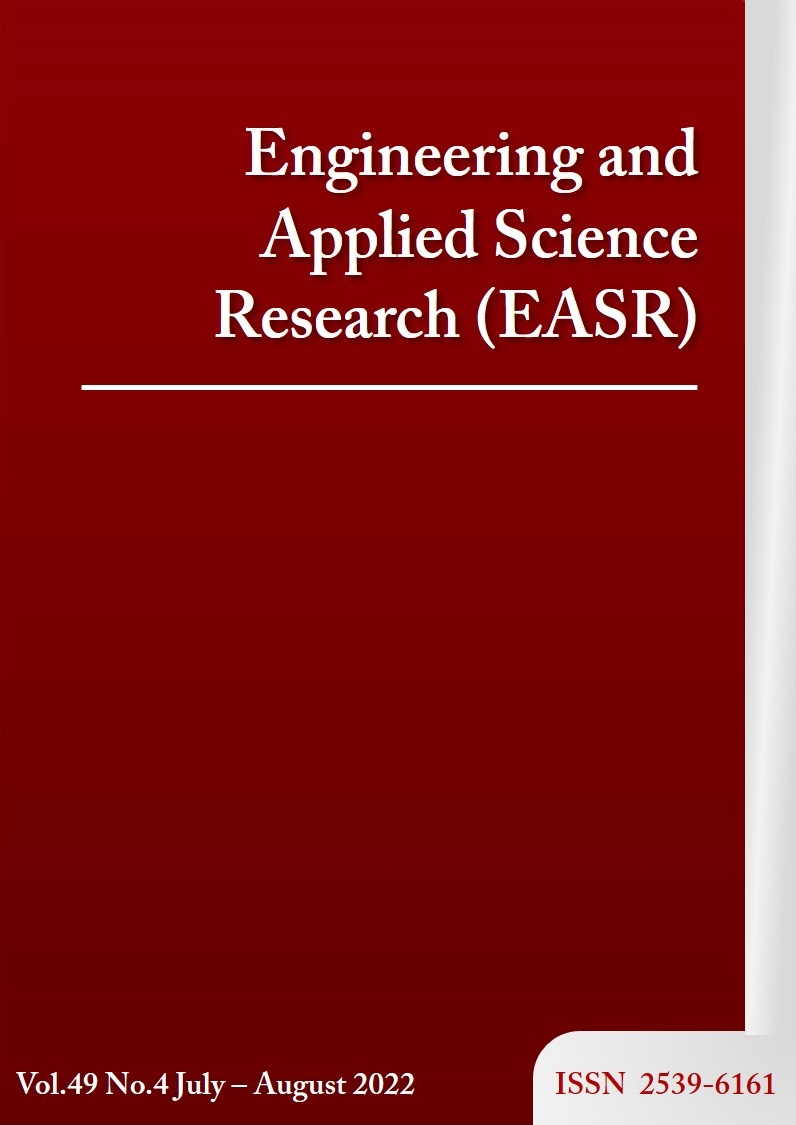DIPDEEP: Classification for Thai dragon fruit
Main Article Content
Abstract
Thai dragon fruit is an interesting fruit with beautiful colors and high nutritional value, which can be used for food and pharmaceutical. In Thailand, there are 7 species of dragon fruits. Its skin can be divided into red or yellow groups, but inside can be divided into white, red or pink groups. If farmers know the species of dragon fruits, they can export fruits at a good price. Most people are unable to distinguish species of the dragon fruits. This paper is focus on classifying species of dragon fruits from images using digital image processing and deep learning called DIPDEEP. The DIPDEEP method has three steps; color space transformation, calculation ratio of the yellow and red color, classification using the deep learning method. First, the Thai dragon fruit images were classified into yellow (1 species) out from red (6 species). The Thai red dragon fruit was resized into 100x100 pixel resolutions in the pre-processing step only 6 species. Then, the red class was sent to classify again using the deep learning method. The experiments were processed in a dataset with 9,754 dragon fruit images on a black background (laboratory), and 10,072 images of dragon fruits at outdoor environment (outdoor). The results showed that accuracy of classification between the red and yellow dragon fruit for laboratory and outdoor datasets was 100% and 95.26%, respectively. The red dragon fruit is classified its species with accuracy 98.80%. The DIPDEEP has the smallest file size, and can save workload time because of separating yellow skin out at first step.
Article Details

This work is licensed under a Creative Commons Attribution-NonCommercial-NoDerivatives 4.0 International License.
This work is licensed under a Creative Commons Attribution-NonCommercial-NoDerivatives 4.0 International License.
References
Abirami K, Swain S, Baskaran V, Venkatesan K, Sakthivel K, Bommayasamy N. Distinguishing three Dragon fruit (Hylocereus spp.) species grown in Andaman and Nicobar Islands of India using morphological, biochemical and molecular traits. Sci Rep. 2021;11:2894.
National Bureau of Agricultural Commodity and Food Standards, Ministry of Agriculture and Cooperatives. Thai agricultural standard: Dragon fruit [Internet]. 2015 [cited 2021 Sep 11]. Available from: https://www.acfs.go.th/standard/ download/eng/DRAGON-FRUIT-ENG.pdf.
Department of agricultural extension, ministry of agriculture and cooperatives. Agricultural production information service system [Internet]. 2020 [cited 2021 Sep 1]. Available from: https://production.doae.go.th/service/site/login.
Parekh R. Fundamentals of image, audio, and video processing using Matlab®: with applications to pattern recognition. Florida: CRC Press; 2021.
Burger W, Burge MJ. Principles of digital image processing fundamental techniques. New York: Springer; 2009.
Elgendy M. Deep learning for vision systems. New York: Manning; 2019.
Latif A, Rasheed A, Sajid U, Ahmed J, Ali N, Ratyal NI, et al. Content-based image retrieval and feature extraction: a comprehensive review. Math Probl Eng. 2019;2019:9658350.
Wang S, Han K, Jin J. Review of image low-level feature extraction methods for content-based image retrieval. Sens Rev. 2019;39(6):783-809.
Samek W, Montavon G, Lapuschkin S, Anders CJ, Müller KR. Explaining deep neural networks and beyond: a review of methods and applications. Proc IEEE. 2021;109(3):247-78.
Schmidhuber J. Deep learning in neural networks: an overview. Neural Netw. 2015;61:85-117.
Hameed K, Chai D, Rassau A. A comprehensive review of fruit and vegetable classification techniques. Image Vis Comput. 2018;80:24-44.
Bani N. T, Fekri-Ershad S. Content-based image retrieval based on combination of texture and colour information extracted in spatial and frequency domains. Electron Libr. 2019;37(4):650-66.
Hamza R, Chtourou M. Design of fuzzy inference system for apple ripeness estimation using gradient method. IET Image Process. 2020;14(3):561-9.
Reyes JF, Contreras E, Correa C, Melin P. Image analysis of real-time classification of cherry fruit from colour features. J Agric Eng. 2021;52(4):1-6.
Cecotti H, Rivera A, Farhadloo M, Pedroza MA. Grape detection with convolutional neural networks. Expert Syst Appl. 2020;159:113588.
He K, Zhang X, Ren S, Sun J. Deep residual learning for image recognition. IEEE Conference on Computer Vision and Pattern Recognition (CVPR); 2016 Jun 27-30; Las Vegas, USA. New York: IEEE; 2016. p. 770-8.
Simonyan K, Zisserman A. Very deep convolutional networks for large-scale image recognition. 3rd International Conference on Learning Representations ICLR; 2015 May 7-9; San Diego, USA. New York: DBLP; 2015. p. 398-406.
Osako Y, Yamane H, Lin SY, Chen PA, Tao R. Cultivar discrimination of litchi fruit images using deep learning. Sci Hortic. 2020;269:109360.
Sandler M, Howard A, Zhu M, Zhmoginov A, Chen LC. MobileNetV2: inverted residuals and linear bottlenecks mark. IEEE/CVF Conference on Computer Vision and Pattern Recognition; 2018 Jun 18-23; Salt Lake City, USA. New York: IEEE; 2018. p. 4510-20.
Mureşan H, Oltean M. Fruit recognition from images using deep learning. Acta Univ Sapientiae Inform. 2018;10(1):26-42.
Inunganbi S, Seal A, Khanna P. Classification of food images through interactive image segmentation. In: Nguyen N, Hoang D, Hong TP, Pham H, Trawiński B, editors. Intelligent information and database systems. Cham: Springer; 2018. p. 519-28.
Momeny M, Jahanbakhshi A, Jafarnezhad K, Zhangd Y. Accurate classification of cherry fruit using deep CNN based on hybrid pooling approach. Postharvest Biol Technol. 2020;166:111204.



